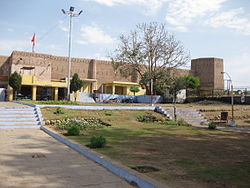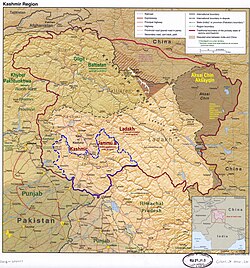District of Jammu and Kashmir administered by India
| Jammu district | |
|---|---|
| District of Jammu and Kashmir administered by India | |
 Bahu Fort, Jammu, India Bahu Fort, Jammu, India | |
| Interactive map of Jammu district | |
 Jammu district is in the Jammu division (shown with neon blue boundary) of Indian-administered Jammu and Kashmir (shaded in tan in the disputed Kashmir region Jammu district is in the Jammu division (shown with neon blue boundary) of Indian-administered Jammu and Kashmir (shaded in tan in the disputed Kashmir region | |
| Coordinates (Jammu): 32°44′N 74°52′E / 32.73°N 74.87°E / 32.73; 74.87 | |
| Administering country | India |
| Union territory | Jammu and Kashmir |
| Division | Jammu Division |
| Headquarters | Jammu |
| Tehsils |
|
| Government | |
| • District Magistrate | Sachin Kumar Vaishya(IAS) |
| • Lok Sabha constituencies | Jammu (Lok Sabha constituency) |
| • Vidhan Sabha constituencies | 11 |
| Area | |
| • Total | 2,342 km (904 sq mi) |
| • Urban | 252.13 km (97.35 sq mi) |
| • Rural | 2,089.87 km (806.90 sq mi) |
| Population | |
| • Total | 1,529,958 |
| • Density | 650/km (1,700/sq mi) |
| • Urban | 765,013 |
| • Rural | 764,945 |
| Demographics | |
| • Literacy | 83.45% |
| • Sex ratio | 880 |
| Time zone | UTC+05:30 (IST) |
| Vehicle registration | JK-02 |
| Website | http://jammu.nic.in/ |
Jammu district is an administrative district of the Jammu division of Indian-administered Jammu and Kashmir in the disputed Kashmir region. It is the most populous district in the Jammu division.
Administrative divisions
Jammu District has 7 Sub-Divisions:
- Jammu South
- Jammu North
- R.S. Pura
- Marh
- Akhnoor
- Chowki Choura
- Khour
There are 21 tehsils:
- Akhnoor
- Arnia
- Bahu
- Bhalwal
- Bishnah
- Chowki Choura
- Dansal
- Jammu
- Jammu North
- Jammu South
- Jammu West
- Jourian
- Kharah Balli
- Khour
- Maira Mandrian
- Mandal
- Marh
- Nagrota
- Pargwal
- Ranbir Singh Pura
- Suchetgarh
There are 20 Blocks:
- Akhnoor
- Arnia
- Bhalwal
- Bhalwal Brahmana
- Bishnah
- Chowki Choura
- Dansal
- Khour
- Kharah Balli
- Maira Mandrian
- Mandal
- Marh
- Mathwar
- Miran Sahib
- Nagrota
- Pargwal
- R.S. Pura
- Samwan
- Satwari
- Suchetgarh
Demographics
| Year | Pop. | ±% |
|---|---|---|
| 1901 | 291,399 | — |
| 1911 | 279,051 | −4.2% |
| 1921 | 285,361 | +2.3% |
| 1931 | 316,647 | +11.0% |
| 1941 | 364,253 | +15.0% |
| 1951 | 401,532 | +10.2% |
| 1961 | 438,810 | +9.3% |
| 1971 | 616,396 | +40.5% |
| 1981 | 792,490 | +28.6% |
| 1991 | 1,043,302 | +31.6% |
| 2001 | 1,357,077 | +30.1% |
| 2011 | 1,529,958 | +12.7% |
| † 1951 and 1991 populations are estimated Source: Census of India | ||
According to the 2011 census Jammu district has a population of 1,526,406, roughly equal to the nation of Gabon or the US state of Hawaii. This gives it a ranking of 326th in India (out of a total of 640). The district has a population density of 596 inhabitants per square kilometre (1,540/sq mi) . Its population growth rate over the decade 2001-2011 was 12.48%. Jammu has a sex ratio of 871 females for every 1000 males, and a literacy rate of 83.98%. The Scheduled Castes and Scheduled Tribes account for 24.7% and 4.5% of the population of the district.
| Religion in Jammu district (2011) | ||||
|---|---|---|---|---|
| Religion | Percent | |||
| Hinduism | 84.27% | |||
| Sikhism | 7.47% | |||
| Islam | 7.03% | |||
| Other or not stated | 1.23% | |||
| Jammu district: religion, gender ratio, and % urban of population, according to the 2011 Census. | |||||||||
|---|---|---|---|---|---|---|---|---|---|
| Hindu | Muslim | Christian | Sikh | Buddhist | Jain | Other | Not stated | Total | |
| Total | 1,289,240 | 107,489 | 12,104 | 114,272 | 470 | 1,987 | 321 | 4,075 | 1,529,958 |
| 84.27% | 7.03% | 0.79% | 7.47% | 0.03% | 0.13% | 0.02% | 0.27% | 100.00% | |
| Male | 685,679 | 56,927 | 6,455 | 61,098 | 266 | 1,038 | 171 | 2,187 | 813,821 |
| Female | 603,561 | 50,562 | 5,649 | 53,174 | 204 | 949 | 150 | 1,888 | 716,137 |
| Gender ratio (% female) | 46.8% | 47.0% | 46.7% | 46.5% | 43.4% | 47.8% | 46.7% | 46.3% | 46.8% |
| Sex ratio (no. of females per 1,000 males) |
880 | 888 | 875 | 870 | – | 914 | – | 863 | 880 |
| Urban | 621,495 | 54,157 | 9,599 | 75,307 | 361 | 1,949 | 156 | 1,989 | 765,013 |
| Rural | 667,745 | 53,332 | 2,505 | 38,965 | 109 | 38 | 165 | 2,086 | 764,945 |
| % Urban | 48.2% | 50.4% | 79.3% | 65.9% | 76.8% | 98.1% | 48.6% | 48.8% | 50.0% |
| Sex Ratio in Jammu District in 2011 Census. (no. females per 1,000 males) | ||||
|---|---|---|---|---|
| Religion (and population) | Sex Ratio | |||
| Hindu (pop 1,289,240) | 880 | |||
| Sikh (pop 114,272) | 870 | |||
| Muslim (pop 107,489) | 888 | |||
| Christian (pop 12,104) | 875 | |||
| Other (pop 2,778) | 883 | |||
| Not stated (pop 4,075) | 863 | |||
| Total (pop 1,529,958) | 880 | |||
Languages
Languages of Jammu district (2011)
Dogri (70.85%) Punjabi (8.10%) Kashmiri (6.00%) Hindi (5.88%) Gojri (3.86%) Others (5.31%)The most widely spoken language of Jammu is Dogri. Other languages spoken are Punjabi, Urdu, Hindi, Kashmiri, Gojri and English.
References
- ^ The application of the term "administered" to the various regions of Kashmir and a mention of the Kashmir dispute is supported by the tertiary sources (a) through (d), reflecting due weight in the coverage. Although "controlled" and "held" are also applied neutrally to the names of the disputants or to the regions administered by them, as evidenced in sources (f) through (h) below, "held" is also considered politicized usage, as is the term "occupied," (see (i) below).
(a) Kashmir, region Indian subcontinent, Encyclopaedia Britannica, retrieved 15 August 2019 (subscription required) Quote: "Kashmir, region of the northwestern Indian subcontinent ... has been the subject of dispute between India and Pakistan since the partition of the Indian subcontinent in 1947. The northern and western portions are administered by Pakistan and comprise three areas: Azad Kashmir, Gilgit, and Baltistan, the last two being part of a territory called the Northern Areas. Administered by India are the southern and southeastern portions, which constitute the state of Jammu and Kashmir but are slated to be split into two union territories.";
(b) Pletcher, Kenneth, Aksai Chin, Plateau Region, Asia, Encyclopaedia Britannica, retrieved 16 August 2019 (subscription required) Quote: "Aksai Chin, Chinese (Pinyin) Aksayqin, portion of the Kashmir region, at the northernmost extent of the Indian subcontinent in south-central Asia. It constitutes nearly all the territory of the Chinese-administered sector of Kashmir that is claimed by India to be part of the Ladakh area of Jammu and Kashmir state.";
(c) "Kashmir", Encyclopedia Americana, Scholastic Library Publishing, 2006, p. 328, ISBN 978-0-7172-0139-6 C. E Bosworth, University of Manchester Quote: "KASHMIR, kash'mer, the northernmost region of the Indian subcontinent, administered partlv by India, partly by Pakistan, and partly by China. The region has been the subject of a bitter dispute between India and Pakistan since they became independent in 1947";
(d) Osmańczyk, Edmund Jan (2003), Encyclopedia of the United Nations and International Agreements: G to M, Taylor & Francis, pp. 1191–, ISBN 978-0-415-93922-5 Quote: "Jammu and Kashmir: Territory in northwestern India, subject to a dispute betw een India and Pakistan. It has borders with Pakistan and China."
(e) Talbot, Ian (2016), A History of Modern South Asia: Politics, States, Diasporas, Yale University Press, pp. 28–29, ISBN 978-0-300-19694-8 Quote: "We move from a disputed international border to a dotted line on the map that represents a military border not recognized in international law. The line of control separates the Indian and Pakistani administered areas of the former Princely State of Jammu and Kashmir.";
(f) Kashmir, region Indian subcontinent, Encyclopaedia Britannica, retrieved 15 August 2019 (subscription required) Quote: "... China became active in the eastern area of Kashmir in the 1950s and has controlled the northeastern part of Ladakh (the easternmost portion of the region) since 1962.";
(g) Bose, Sumantra (2009), Kashmir: Roots of Conflict, Paths to Peace, Harvard University Press, pp. 294, 291, 293, ISBN 978-0-674-02855-5 Quote: "J&K: Jammu and Kashmir. The former princely state that is the subject of the Kashmir dispute. Besides IJK (Indian-controlled Jammu and Kashmir. The larger and more populous part of the former princely state. It has a population of slightly over 10 million, and comprises three regions: Kashmir Valley, Jammu, and Ladakh.) and AJK ('Azad" (Free) Jammu and Kashmir. The more populous part of Pakistani-controlled J&K, with a population of approximately 2.5 million. AJK has six districts: Muzaffarabad, Mirpur, Bagh, Kodi, Rawalakot, and Poonch. Its capital is the town of Muzaffarabad. AJK has its own institutions, but its political life is heavily controlled by Pakistani authorities, especially the military), it includes the sparsely populated "Northern Areas" of Gilgit and Baltistan, remote mountainous regions which are directly administered, unlike AJK, by the Pakistani central authorities, and some high-altitude uninhabitable tracts under Chinese control."
(h) Fisher, Michael H. (2018), An Environmental History of India: From Earliest Times to the Twenty-First Century, Cambridge University Press, p. 166, ISBN 978-1-107-11162-2 Quote: "Kashmir’s identity remains hotly disputed with a UN-supervised “Line of Control” still separating Pakistani-held Azad (“Free”) Kashmir from Indian-held Kashmir.";
(i) Snedden, Christopher (2015), Understanding Kashmir and Kashmiris, Oxford University Press, p. 10, ISBN 978-1-84904-621-3 Quote:"Some politicised terms also are used to describe parts of J&K. These terms include the words 'occupied' and 'held'." - District Census Handbook Jammu, Part A (PDF). Census of India 2011 (Report). 18 June 2014. pp. 13, 51, 116. Retrieved 21 November 2020.
District Census Handbook Jammu, Part B (PDF). Census of India 2011 (Report). 16 June 2014. pp. 13, 24. Retrieved 21 November 2020. - ^ C-1 Population By Religious Community – Jammu & Kashmir (Report). Office of the Registrar General & Census Commissioner, India. Retrieved 28 July 2020.
- 2011 census J&K
- "Tehsil", District Jammu, Jammu And Kashmir, retrieved 3 May 2021 – via National Informatics Centre, Ministry Of Electronics & Information Technology, Government Of India
- "A-2 Decadal Variation In Population Since 1901". Censusindia.gov.in. Retrieved 9 August 2019.
- US Directorate of Intelligence. "Country Comparison:Population". Archived from the original on 13 June 2007. Retrieved 1 October 2011.
Gabon 1,576,665
- "2010 Resident Population Data". U. S. Census Bureau. Archived from the original on 27 December 2010. Retrieved 30 September 2011.
Hawaii 1,360,301
- "Jammu District Population Religion - Jammu and Kashmir, Jammu Literacy, Sex Ratio - Census India". www.censusindia.co.in. Retrieved 10 June 2023.
- C-16 Population By Mother Tongue – Jammu & Kashmir (Report). Office of the Registrar General & Census Commissioner, India. Retrieved 18 July 2020.
External links
| Places adjacent to Jammu district | ||||||||||||||||
|---|---|---|---|---|---|---|---|---|---|---|---|---|---|---|---|---|
| ||||||||||||||||
| Jammu district | |
|---|---|
| Cities and towns |
|
| Villages | |